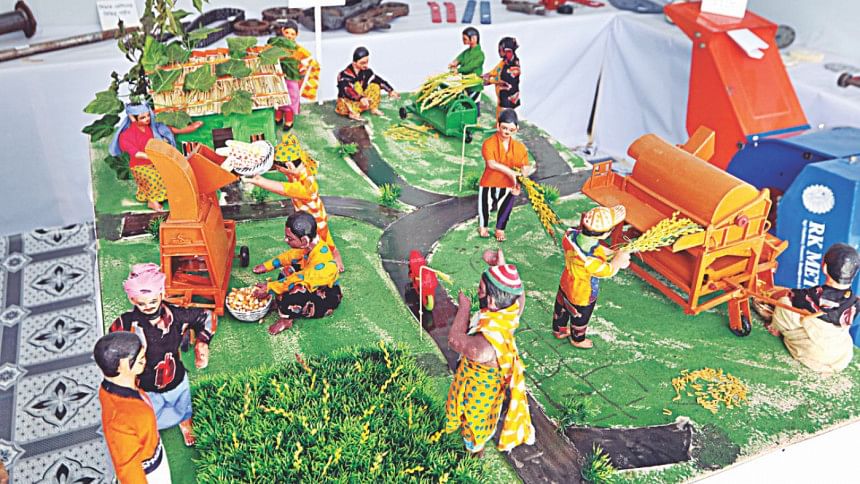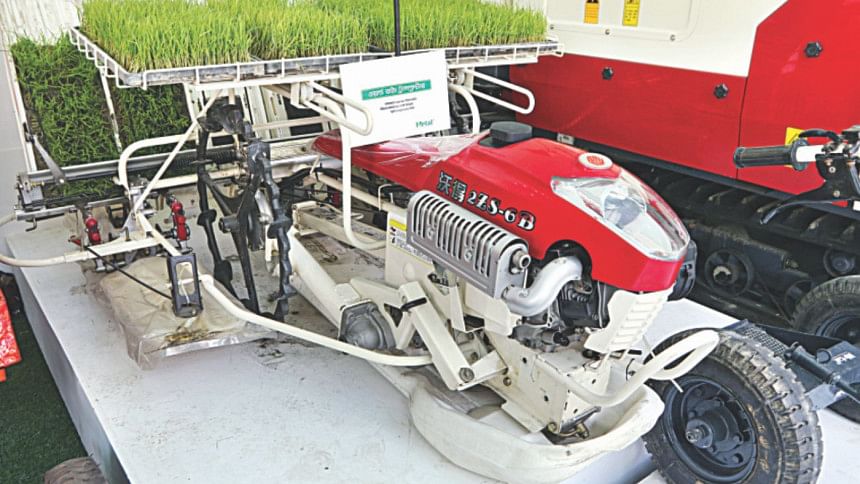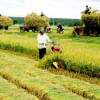Today's Farming: Up to 90pc mechanised

Two years have passed. Yet the scenes of the onrushing water submerging ripening paddy fields remain fresh in the mind of Matindra Sarker, a farmer in the northeastern district of Netrakona.
This year though, Matindra is relaxed. He does not need to wait for farm labourers to harvest the paddy anymore owing to his combine harvester. The shift towards automation is dramatically changing the farming scenario in the country.
During the flood, the 66-year old could not harvest paddy from two acres of land due to the dearth of workers even after he had paid Tk 10,000, forty-three percent higher than the usual rate, to harvest crop from each acre.
Helplessly, he saw his hard work wash away. This year though, he is no longer powerless.
“This [the combine harvester] gives me a lot of strength. I will be able to harvest my ripen paddy even if water comes,” Matindra said over phone.
With the machine, paddy on each bigha (33 decimal) could be harvested in less than one and a half hours, whereas 7-8 hours would be required if the same amount of land is harvested by five people, he said.
Matindra bought the combine harvester in May last year, frustrated by the lack of farmhands. As more local workers move away from the agricultural industry, the wages of the remaining ones have risen.
However, now Matindra has another option besides manual labour. Even for tilling his land, he can avail tractors and power tillers from rental service providers. The same service is also available for threshing grain. After using the combine harvester, he will have to hire workers for seeding and transplanting the 12 acre he owns.
“Machines have made farming convenient. It saves our time and money,” said the member of the 1.51 crore farm families, who are gradually switching to fully mechanised cultivation in the face of spiraling wages.
Today, up to 95 percent of land is tilled by power tillers and tractors. Machines are also used for 90 percent of pesticide applications. Most of the grains, particularly rice, are threshed by machines, according to estimates by the Department of Agricultural Extension (DAE).
On the other hand, further expansion of mechanised means for seeding, transplanting and harvesting has been slow owing to a lack of machines that are suitable for the many different types of land, fragmented ownership, limited use and relatively higher prices, said some farmers and a senior official of a farm machinery marketer.

Some one percent of transplanting and harvesting is done by machines, according to the DAE, which also estimates that a farmer would require Tk 8,000 if he manually harvests and threshes crops from one acre of land. The cost will decline to Tk 3,000 per acre if a combine harvester is used.
Use of a combine harvester will facilitate farmers in harvesting and threshing crops in six hours compared to 128 hours when the same is done manually.
Use of rice transplanter will help growers save Tk 5,000 and 74 hours on each acre, estimates the DAE.
Refayet Ullah, a farmer at Pirgacha of Rangpur, said the use of machines has allowed them to cultivate crops timely and at a reduced cost. “As a result, we can all cultivate in almost the same time and crops remain less prone to disease,” he said, “Yields have also increased.”
Refayet said he rents a power tiller for Tk 600 to prepare 22 decimal of land.
“In my locality there are four power tiller rental services. Therefore, the price is affordable.”
To irrigate the fields he pays Tk 1000 per 22 decimal a season.
He said combine harvester would be beneficial for them. But its price is too high for farmers to bear as the use of the machine is limited to one month in a season, adding that the cost of a combine harvester currently stands at Tk 8-9 lakh.
The government should take steps to reduce the cost of farm machinery, he said.
Wali Ullah, a farmer in Ujirpur of Barisal, said the use of animals for tilling has come down to almost nil because of increased use of power tillers and tractors.
“We still harvest paddy manually as large harvesting machines are not suitable as the land is swampy here. Reaper is also not becoming popular as we have to hire workers to transport harvested paddy to the yards,” he said.
Rafiqul Islam, a farmer at Lalmonirhat, a bordering district in the northwest, said reapers are not becoming popular as growers have to hire workers to transport harvested crop. As a result, cost almost becomes equal the expenses for manual harvesting, he added.
“None wants to leave straw in the field. This is valuable as it is used for cattle feed,” he said.
Saiful Islam, a farmer at Kotchandpur upazila of Jhenidah, said the use of machines in farm operations, particularly for tilling and threshing, has enabled him to bag three crops a year because of reduction in turnaround time.
“With the tractor, we can till land just after harvesting crop. This was not possible when we prepared lands manually with draught animals,” he said.
“We grow more today than in the past. But it is sad that we do not get fair prices,” said Saiful.
Md Monjurul Alam, professor of Farm Power and Machinery at the Bangladesh Agricultural University (BAU) said mechanised cultivation reduces time and labour by 30 percent. Use of machines for seeding and fertilizer application also saves seeds and fertilizer, he added.
As less time is required for cultivation, use of machines also helps increases cropping intensity by 20 percent, he said citing a 2006 study.
“Mechanisation has played a big role in increasing cropping intensity in recent years,” said Monjurul.
“As a whole, production increases by 15 percent.”
Sheikh Md Nazim Uddin, project director of farm mechanisation project phase-II under the Ministry of Agriculture, said mechanisation also helps reduce handling losses.
Subrata Ranjan Das, executive director of ACI Motors, a concern of ACI Ltd, said mechanisation is needed to attract the young generation to farming. “They will not do everything manually,” he said.
He said mechanisation has expanded mainly because of growth of the rental service market.
“Given average farm land holding of 25 decimal, this is not feasible for a farmer to buy all equipments to mechanise farming,” he said, suggesting provision of easy and low cost loans for rental service providers.
Use of combine harvester remains at a trial and error phase and fragmented land ownership, lack of drainage system and absence of roads in the crop fields slows adoption of the technology, he said.
“Equipment, depending on the environment of every area, should be introduced to increase pace of mechanisation.”
In 2009, the government took up a Tk 150 crore scheme to speed up farm mechanisation by offering 25 percent subsidy for agricultural machineries such as power tillers, tractors, power threshers and combine harvesters, according to DAE.
Later, the project was extended till June 2019 and the government raised the subsidy to farmers for purchase of agriculture machinery to 50 percent in two phases. The amount of subsidy was raised to 70 percent in January last year.
Matindra bought the small combine harvester by paying Tk 2.14 lakh and the rest was borne by the government.
During the immediate aman harvesting season, he used the machine to harvest paddy on 20 acres. He is waiting to use the machine to harvest the boro paddy by the end of April.
“The crop so far looks good,” he said.

 For all latest news, follow The Daily Star's Google News channel.
For all latest news, follow The Daily Star's Google News channel. 








Comments